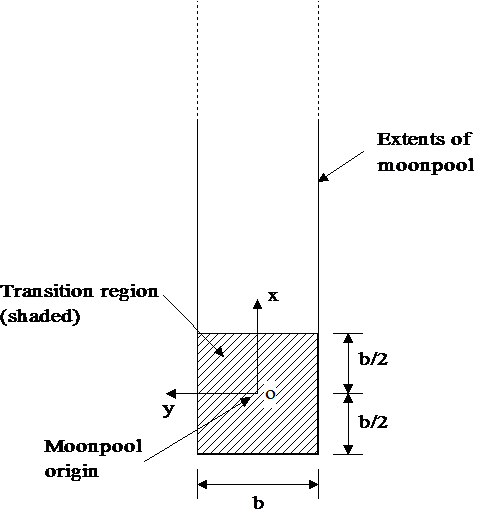Flexcom provides comprehensive modelling capabilities intended specifically for the analysis of Spar or DDCV risers. One of these is the ability to specify that hydrodynamic loads on sections of riser contained within the Spar moonpool are based on the water particle velocities and accelerations within the moonpool. Flexcom assumes that the vessel moonpool entrains a body of water, that is, that the water within the vessel moonpool moves with the vessel. So water particle velocities and accelerations used in calculating Morison’s Equation forces are calculated from the vessel motions, rather than from the ambient wave field. The moonpool is assumed to have a square cross-section and extends from a user-specified level up to the Mean Water Line.
There are two main steps involved in modelling the hydrodynamic loading on sections of the structure contained within a moonpool. The first step is to define the volume contained within the vessel moonpool at the initial static analysis stage. This is done by specifying the following data:
(i)The vessel with which the moonpool is associated. The volume enclosed by the moonpool moves with this vessel throughout the analysis, and the water particle velocities and accelerations within the moonpool are calculated from the motion of this vessel.
(ii)The location of the moonpool at the start of the analysis. This is specified by inputting the global coordinates of a particular point at the bottom of the moonpool when defining model geometry and properties.
(iii)The initial yaw orientation of the moonpool. As the moonpool is assumed to have a square cross-section, this entry simply defines the orientation of the moonpool in the global-YZ plane. This is usually the same as the yaw orientation of the relevant vessel.
(iv)The width of the moonpool.
The second step in modelling moonpool hydrodynamics is to identify elements of the structure that may be subject to hydrodynamic loading within the vessel moonpool.
What happens when elements are assigned moonpool hydrodynamic coefficients is that the program checks at each solution time whether each integration point on a given element is within the volume enclosed by the vessel moonpool at that particular time, or if it is in the so-called transition region, or if it is completely outside the influence of the vessel moonpool. If it is within the volume enclosed by the moonpool, then the water particle velocities and accelerations used in calculating the Morison’s Equation force at the integration point are calculated from the vessel motions. If the integration point is outside the influence of the moonpool, the water particle velocities and accelerations are calculated from the ambient wave field. If the integration point is within the transition region, then the water particle velocities and accelerations are interpolated linearly from those in the moonpool and those in the wave field. In this way, the program automatically accounts for elements that may move in and out of the vessel moonpool during the course of an analysis.
In order to avoid a discontinuity in the water particle velocities and accelerations at the boundary between the volume enclosed by the moonpool and the ambient wave field (which could result in a discontinuity in the hydrodynamic loads applied to the structure), a transition region is defined at this location. Across this transition region, the water particle velocities and accelerations vary linearly from those in the moonpool to those in the ambient wave field. The transition region extends from a distance equal to one-half the moonpool width below the moonpool origin to one-half the moonpool width above the moonpool origin, as shown in the below figure.

A final point to note is that only constant hydrodynamic coefficients may be specified for moonpool hydrodynamic sets; hydrodynamic coefficients may not be specified as a function of Reynolds number.
•*MOONPOOL is used to define the location and extent of the vessel moonpool.
•*HYDRODYNAMIC SETS is used to assign hydrodynamic coefficients to element sets. Specifically, the TYPE=MOONPOOL input is used to assign hydrodynamic coefficients to elements of the structure that may be subjected to hydrodynamic loading within a vessel moonpool.
If you would like to see an example of how these keywords are used in practice, refer to A02 - Spar Production Riser.